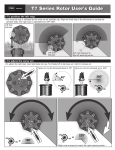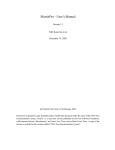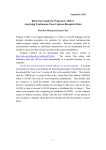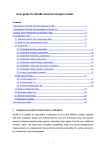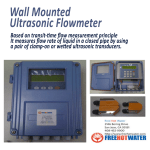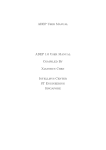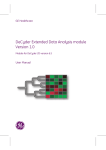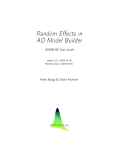Download FLOWNORM 1
Transcript
WETDEPNORM 1.0
- a Visual Basic program for computing
wet deposition of substances and
extracting anthropogenic signals from
time series of deposition data
User’s Manual
2005-04-14
Claudia Libiseller
Department of Mathematics
Linköping University
Introduction
en sammanfattning., kanske från artikeln
The Visual Basic programme WETDEPNORM has been developed to facilitate:
- calculation of substance deposition;
- extraction of anthropogenic signals from time series of deposition data.
WETDEPNORM, Version 1.0, consists of five Visual Basic macros having the names
and functions listed below. Two Excel worksheets containing concentration and
precipitation data for the sampling site form the starting point for an analysis. It is also
possible to include sector information on these worksheets. The final result consists of
time series of normalised loads, i.e. deposition values that have been adjusted to
remove natural fluctuations and clarify anthropogenic impacts. Theoretical details
can be found in the end of this description.
Macro
Function
auditdailydata
Identify illegal entries in raw data
matchprecipandconc
Define pairs of precipitation/sector and concentration
data for load calculations
compute_deposition
Compute monthly and annual deposition from
precipitation and concentration data ordered by date
definenormalisationmodels Define response variables and normalisation models
wet_dep_normalise
Select normalisation models by cross-validation and
compute monthly and annual normalised deposition
Each macro operates on predefined worksheets for inputs and outputs. The table
below shows which worksheets that are used for the different macros. Further details
are given in the documentation of each macro.
Macro
Input worksheets
Output worksheets
auditdailydata
"Concentration by date"
or "Precip and sector by
date"
The same as input, and
"Concentration data summary”
or "Precipitation data summary”
matchflowandcons
"Concentration by date"
and "Precip and sector
by date"
"Matched pairs"
compute_deposition
"Matched pairs", "Precip
and sector by date", and
"Concentration by date"
"Annual totals" and "Seasonal or
sector totals"
definenormalisationmodels
"Seasonal or sector
totals"
"Normalisation models"
wet_dep_normalise
"Normalisation models"
"Normalisation models",
"Normalised seasonal totals",
and "Normalised annual totals"
2
Running the WETDEPNORM programme
Copy data to worksheets
Run macro 'Auditdailydata'
Input and
data checking
Select analysis
on 'Model selection' worksheet
Run macro
Computation of
deposition
'Compute_depostion'
Indicate response and explanatory
variables for the normalisation model
Define models
and compute
normalised values
Run macro
'definenormalisationmodels'
Run macro
'wet_dep_normalise'
3
Input and data checking
Copy data to worksheets
The concentration and precipitation data (and sector data if necessary) are copied to
the worksheets 'Concentration by date" and 'Precip and sector by date', respectively.
Figure 1 shows how the input data shall be organised for the worksheet 'Concentration
by date'. The date column shall be followed by an arbitrary number of columns
containing the values of the monitored variables. Strings found in the row
immediately above the first observations (row 2 in Figure 1) are interpreted as
variable names. Sampling site names are extracted from the cell two lines above the
first date. Missing values shall be entered as empty cells. 'Less-than-values' of the
form <0.05 are permitted. Figure 2 illustrates the 'Precip and sector by date'
worksheet. The format of data inserted is the same as for concentration data, but
notice that precipitation data should be given in column 2 and sector in column 3.
Sector data should be given as values 1-8 for classified sectors and 9 for remaining
(missing or unclassified).
Sampling site
Variable names
Date column
Figure 1: The worksheet ' Concentration by date'. Insert you concentration data.
4
Sampling site
Variable names
Date column
Figure 2: The 'Precip and sector by date' worksheet. Insert precipitation and sector
data here. Sector data should be given in the third column, and can be omitted if the
analysis is done on seasonal data only.
5
Run macro 'Auditdailydata'
This macro checks that the data pasted on the worksheets 'Concentration by date' and
'Precip and sector by date' are of correct type and properly organised. When
'Auditdailydata' is run, the macro first identifies the name of active worksheet
('Concentration by date' or 'Precip and sector by date'), and then the first cell
containing date values.
Figure 3: 'Concentration by date' worksheet after the macro 'Auditdailydata' was run.
The first data row is moved to row five.
6
Run macro 'matchprecipandconc'
This macro facilitates the matching of precipitation/sector values and concentration
data for deposition calculations. Based on the identified names of the sampling sites
for flow and concentration the macro prints a preliminary list of matched pairs on the
worksheet ‘Matched pairs’. This list can then be edited prior to the load calculations.
Figure 4 shows the result of the 'matchprecipandconc' macro on the 'Matched pairs'
worksheet. In our dataset both series (precipitation and concentration) were labelled
correctly with the site name 'Birkenes'. The macro matches the two series. If the series
were labelled using different site names, but should be analysed together, the
combinations on the 'Matched Pairs' worksheet can be edited now.
Site names are
matched correctly
Figure 4: The matched pairs as result of the macro 'matchprecipandconc'.
7
Select Analysis
On the worksheet 'Model selection' you have to choose, if the computation of
depositions and the normalisation of depositions should be done on annual summaries
by sector or on seasonal summaries. One of the methods has to chosen and it is not
possible to choose both at the same time, this implies that one of the cells must be
empty, while the other contains a 'yes' or 'y'. When one of the classification methods is
chosen for the computation of deposition, also the normalisation of deposition must be
conducted using the same classification.
Select season of sector
by writing 'yes' or 'y' in
the adjacent cell
Figure 5: Select which class to use (season or sector) for computation of deposition
and normalisation of deposition.
8
Computation of depositions
Run macro 'Compute_deposition'
This macro operates on the worksheets 'Model selection', 'Precip and sector by date',
'Concentration by date' and 'Matched pairs'. The output worksheets are 'Annual totals'
and 'Monthly or sector totals'. 'Less-than-values' are replaced by a fixed percentage of
the detection limit. The user is asked to enter the desired percentage when the macro
is run.
In Figure 6 the computation of deposition is made by sector, giving 9 outputs per year.
The response variables NH4 and NO3 concentrations and precipitation are used to
compute annual deposition by sector. The explanatory variable precipitation forms
three new variables: annual precipitation amount by sector, number of precipitation
days per sector, number of precipitation periods (=1st day of several consecutive
precipitation days) per sector.
Computation of depositions by seasons works in the same way, then 12 values are
given for each year, the variables computed are the same.
Figure 6: Annual deposition by sector. Besides NH4 and NO3 deposition and
precipitation amount by sector two new variables are added: raindays (number of
precipitation days per sector) and rainperiods (number of 1st days of longer
precipitation periods) per sector.
9
Define normalisation models and compute normalised
values
Indicate response and explanatory variables
In this step the user must indicate which variables should be interpreted as
explanatory and response variables, respectively. This is done by writing 'x' for
explanatory variables and 'y' for response variables in the second row just above the
data columns that are chosen.
y indicates that NH4 deposition
and NO3 deposition are chosen
as response variables
x indicates that precipitation
and raindays are chosen as
explanatory variables
Figure 7: Indicate explanatory variables by 'x' and response variables by 'y'.
Run macro 'definenormalisationmodels'
After indicating explanatory and response variables run the macro
'definenormalisationmodels', which combines the variables in all possible ways (See
Figure 8 shows the output of this macro on the worksheet 'Normalisation models'.
Also this sheet can be edited prior to further analysis (Figure 9).
10
For each response variable
different models are given
combining all explanatory variables
in various ways
Figure 8: Output of the macro ' definenormalisationmodels' on the worksheet
'Normalisation Models'.
The models containing only Raindays
as explanatory variables are removed.
The four remaining models are given
on the worksheet.left.
Figure 9 The worksheet 'Normalisation Models' after editing.
11
Run macro ' wet_dep_normalise'
This macro aims to remove or suppress the natural variation in deposition data (either
monthly or annual by sector). The different normalisation models to be computed are
read from the worksheet ‘Normalisation models’. Input data are read from the
worksheet ‘Seasonal and sectoral totals’, and the outputs of the macro are printed on
the worksheets ‘Normalised annual totals’ (see Figure 11) and ‘Normalised seasonal
totals’ (Figure10).
When running the macro 'wet_dep_normalise, there are two possibilities:
- use cross-validation to determine smoothing parameters (recommended)
- insert smoothing parameters manually.
After you start the program you will see a message box asking if cross-validation
should be used. Insert 'yes' for cross-validation and 'no' for manual input. If you
choose cross-validation the macro will start running, if you choose manual you get a
new message box asking for the first smoothing parameter (determining the
smoothness between years) and after that a last message box asking for the second
smoothing parameter (determining the smoothness between classes, i.e. sectors or
seasons).
Deposition values
Normalised values using
a regression model
(Reg-normalised
Normalised values using
a semi-parametric model
(SP-normalised)
Figure 10: Output on the worksheet 'Normalised seasonal totals'. For each model
defined on the worksheet 'Normalisation models' three outputs are given: deposition
values, SP-normalised and Reg-normalised values. The same output can be found on
the worksheet 'Normalised annual totals', but there aggregated for each year
12
On the worksheet 'Normalisation Models' (Figure 11) some information on the fitted
models can be found. In the first columns after the chosen explanatory variables the
number of observations is given. Then the smoothing parameters are listed as
Lambda1 and Lambda2. Furthermore Mean squared prediction error (MSPE) and
mean squared residuals (MSRes) are given for all combinations of explanatory and
response variables and for both the semi-parametric and the regression approach.
Smoothing parameters
are listed for all models
Mean squared prediction errors
are listed for model comparison
Figure 11: The output on the worksheet 'Normalisation models'.
The estimated intercepts of the semi-parametric models are given on the worksheet
'Intercept' (Figure 12). In this case nine columns are given for each pre-specified
model providing a time-varying intercept for each sector.
Normalised values from a simple regression model, only using annual deposition and
annual precipitation amount is also provided. This can be found on the worksheet
'Simple Regression Model'. No picture is given here.
13
Figure 12: On the worksheet 'Intercept' the estimated time-varying intercept for each
class is given.
14
Theoretical background
Estimation of monthly and annual deposition and annual deposition by sector
Monthly and annual deposition data are calculated by first replacing all missing
precipitation data by zeros. Missing sector values are replaced by sector value 9, and
missing concentrations are imputed by a simple regression model using precipitation
amount as explanatory variable. Subsequently daily concentration is multiplied with
daily precipitation values and then summed up to form monthly or annual data by
sector.
Normalisation of deposition data
Deposition data is normalised by employing parametric and semiparametric
regression models to remove or suppress the temporal variation that can be attributed
to fluctuations in precipitation.
The normalisation can be conducted on two different kinds of input data, either
monthly deposition or annual deposition by sector. We therefore use the term class,
with means either month or sector. The semiparametric normalisation model has then
the general form:
y ij = α ij + β 1, j x1,ij + ... + β p , j x p ,ij + ε ij , i = 1, ... , n
j = 1, ... , m
where yij is the observed response for the jth class of the ith year, xk,ij, k=1, … ,p
represent precipitation values, number of precipitation days and/or number or
precipitation periods, and εij is a random error term with mean zero. The slope
parameters (βk,j, k=1, … ,p) are permitted to vary with the class (j) under
consideration, and the intercept (αij) is permitted to vary with both class (j) and year
(i). However, rapid changes in the intercept are controlled by so-called roughness
penalty factors (λ1 and λ2), and the intercept and slope parameters are estimated by
minimising the expressions:
for seasonal data:
S (α , β ) = ∑ ( yij − α ij − β 1, j x1,ij − ... − β p , j x p ,ij ) 2 + λ1 ∑ (α ij −
i, j
+ λ2 ∑ (α ij −
i, j
i, j
α i , j −1 + α i , j +1
2
α i +1, j + α i −1, j
2
)2 ,
where
α i , 0 = α i −1, m , i = 2, K , n; α i ,m +1 = α i +1,1 , i = 1, K , n − 1
to ensure that smoothness between december one year and january the next year.
for data by sector:
15
)2
r n −1
α i +1, j + α i −1, j
j =1i = 2
2
S (α , β ) = ∑ ( yij − α ij − β1, j x1, ij − ... − β p, j x p, ij ) 2 + λ1 ∑ ∑ (α ij −
i, j
)2
⎧n ⎛
α i, j −1 + α i, j +1 2
α i, r + α i,2 2 r −1
α i, r −1 + α i,1 2 ⎞⎟⎫⎪
⎪
) + ∑ (α ij −
) + (α ir −
) ⎬
+ λ2 ⎨∑ ⎜ (α i1 −
⎜
⎟
2
2
2
⎪⎩i =1⎝
j =2
⎠⎪⎭
n −1
α i +1, r +1 + α i −1, r +1 2
+ λ1 ∑ (α i, r +1 −
)
2
i=2
Detailed information about algorithms for parameter estimation of the seasonal model
has been published by Stålnacke and Grimvall (2001). Details for the model using
sectoral data can be found in Libiseller et al.(2005)
The parametric normalisation model is an ordinary multiple regression model of the
general form
y ij = α + β 1, j x1,ij + ... + β p , j x p ,ij + ε ij , i = 1,..., n
j = 1,..., m
where yij, xk,ij, and εij have the same meaning as above. The slope parameters (βk,j,
k=1, … ,p) are permitted to vary with the class (j) under consideration, whereas the
intercept is assumed to be constant.
Selection of roughness penalty factors and assessment of the predictive
ability of the tested normalisation models
If the penalty factors λ1 and λ2 are determined by cross-validation, the entire data set
is separated into an estimation set (or training set) and a test set. The model is first
fitted to the estimation set and is subsequently used to predict the observations in the
test set, that is, the values that have been left out of the estimation step. If the
observation period covers m years, we define m estimation sets Mi, i=1, … ,m by
leaving out one-year-long blocks of observations, and then we compute a so-called
PRESS-value (i.e., a sum of squared prediction errors):
S (λ1 , λ 2 ) = ∑
i
∑(y
( i , j )∉M i
ij
− αˆ ij − βˆ1, j x1,ij − ... − βˆ p , j x p ,ij ) 2 .
Finally, the factors λ1 and λ2 are selected in such a way that S(λ1,λ2) is minimised,
and the corresponding Root Mean PRESS value
⎧ 1
⎫
min ⎨
S (λ1 , λ 2 ) ; λ1 > 0, λ 2 > 0⎬
⎩ N
⎭
is used as a measure of the predictive ability of the normalisation model under
consideration.
Literature references
Libiseller C., Grimvall A. and Hallberg L. (2005) Meteorological normalisation of
time series of wet deposition (manuscript).
16
Stålnacke, P., and Grimvall, A.: 2001, 'Semiparametric approaches to flownormalisation and source apportionment of substance transport in rivers',
Environmetrics 12, 233-250.
17

















